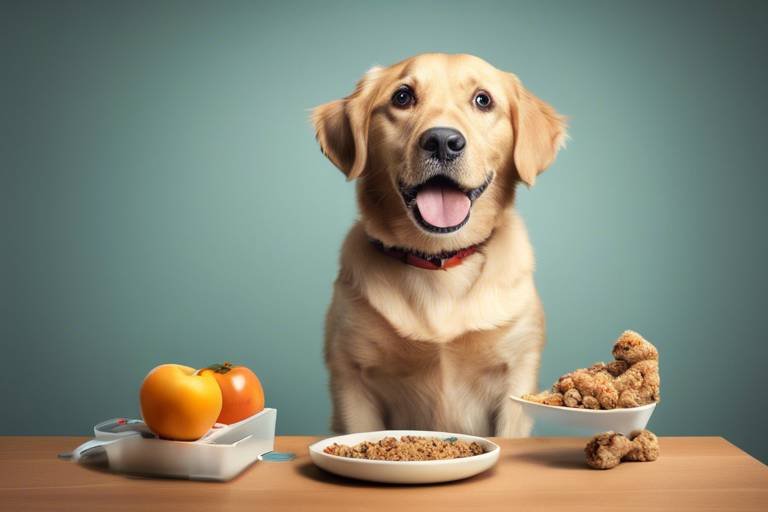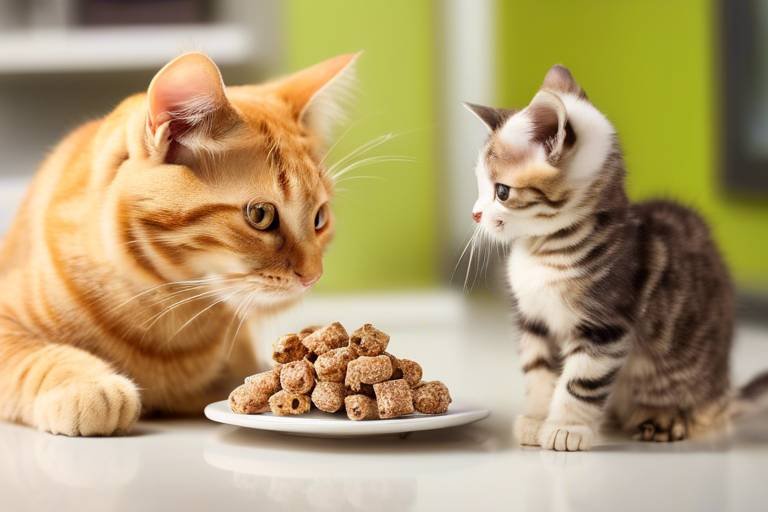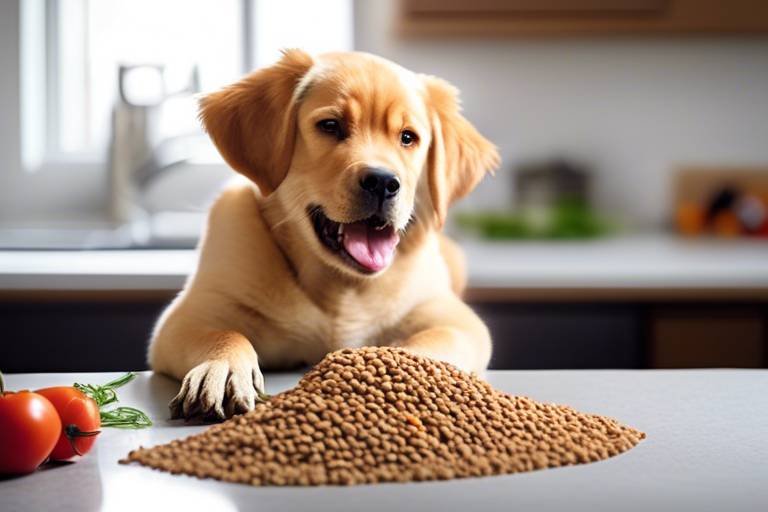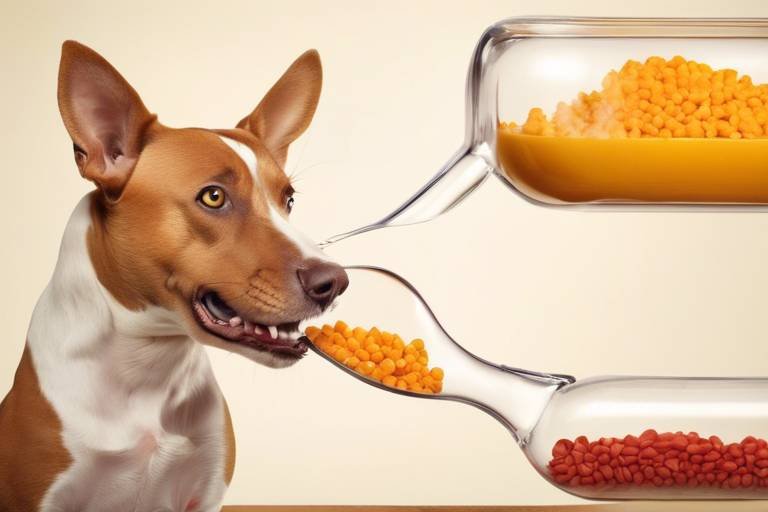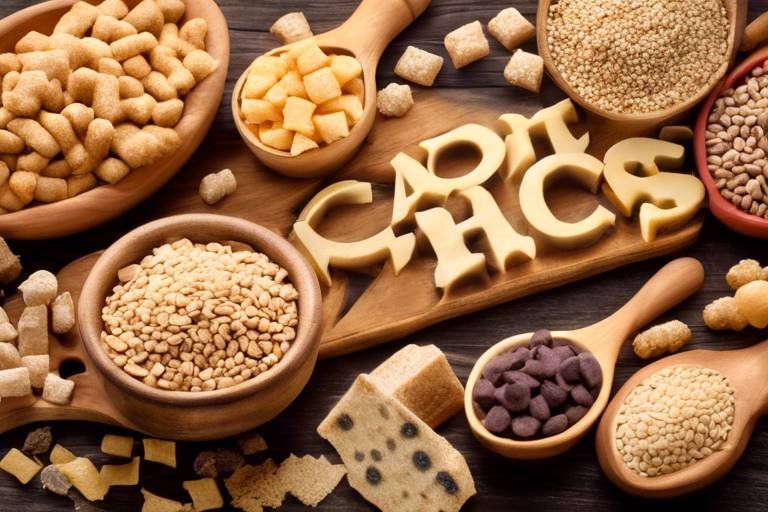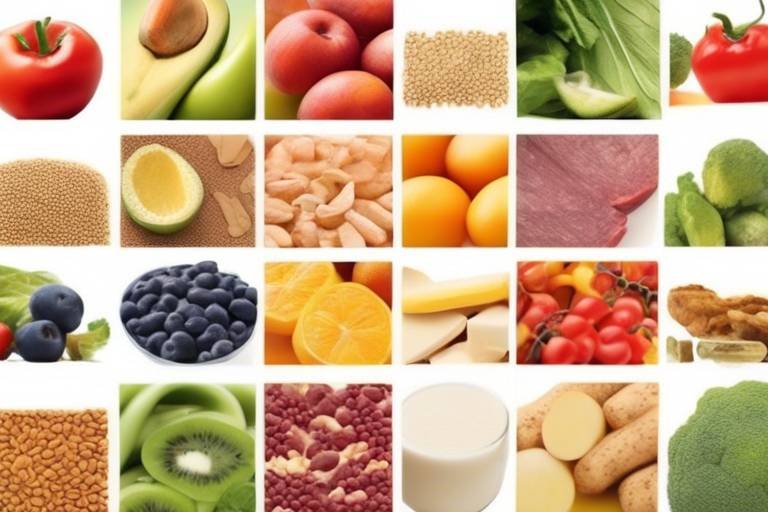How to Help Your Pet Adapt to a New Diet
Changing your pet's diet can feel like a daunting task, but it doesn't have to be! Just like us, our furry friends can be a bit picky or resistant to change. However, with the right approach, you can make this transition as smooth as possible. Think of it as introducing a new recipe to a family member who has their favorite dish—patience and understanding are key! In this article, we'll explore effective strategies to help your pet adapt to a new diet, ensuring their health and happiness while minimizing any stress during the change.
Before diving into the world of pet food, it's essential to understand your pet's specific nutritional needs. Just like humans, pets have unique dietary requirements based on their age, breed, and health conditions. For instance, a growing puppy has different needs compared to a senior dog. Similarly, a cat with a sensitive stomach will require a different diet than one that is healthy and active. To assess these needs, consider consulting your veterinarian, who can provide tailored advice based on your pet's lifestyle and health profile. Remember, a well-fed pet is a happy pet!
Once you have a grasp on your pet's nutritional requirements, the next step is choosing the right food. With so many options available, it can be overwhelming to find high-quality pet food that meets your pet’s dietary needs and preferences. Start by looking for products that list a specific meat as the first ingredient, as this is a good indicator of quality. Additionally, consider your pet's taste preferences—some pets may prefer wet food over dry, or vice versa. It's all about finding that perfect match!
Learning to read pet food labels is crucial in making informed choices. Many pet owners overlook this step, but understanding what goes into your pet's food can make a world of difference. Look for the following on the label:
- Ingredient list: Ingredients are listed by weight, so the first few should be high-quality proteins.
- Nutritional adequacy statement: This tells you if the food meets the standards set by the Association of American Feed Control Officials (AAFCO).
- Guaranteed analysis: This section provides information on the nutrient content, including protein, fat, and fiber levels.
When selecting pet food, it's just as important to know what to avoid. Certain ingredients can be harmful to pets and may lead to health issues. Here are some common additives and fillers to steer clear of:
- By-products: These are often low-quality ingredients that can include animal parts not fit for human consumption.
- Artificial preservatives: Ingredients like BHA, BHT, and ethoxyquin can be harmful in the long run.
- Excessive fillers: Ingredients like corn and soy provide little nutritional value and can lead to obesity.
On the flip side, understanding what constitutes quality ingredients is vital for your pet's health. Look for beneficial components such as:
- Whole meats: These provide essential amino acids necessary for muscle development.
- Whole grains: Ingredients like brown rice and oats offer fiber and energy.
- Fruits and vegetables: These are packed with vitamins and minerals that support overall health.
Now that you've chosen a suitable food, it's time to transition your pet to their new diet. Gradually introducing the new food helps prevent digestive issues and eases the change. Start by mixing a small amount of the new food with their current diet. Over the course of about a week, gradually increase the proportion of the new food while decreasing the old. This slow transition allows your pet's digestive system to adjust without causing upset. Remember, patience is key—if your pet seems resistant, don’t rush the process!
As your pet adapts to their new diet, it's crucial to monitor their response. Keep an eye out for any signs of discomfort or changes in behavior. Some common signs to watch for include:
- Changes in appetite: Is your pet eating less or more than usual?
- Digestive issues: Look out for diarrhea or vomiting, which may indicate a food intolerance.
- Energy levels: Is your pet more active or lethargic than before?
Some pets may experience allergies to new foods, which can manifest in various ways. Common symptoms include itching, redness, and gastrointestinal upset. If you notice any of these signs, consult your veterinarian immediately. They can help determine whether the new diet is the culprit and suggest alternatives.
Proper portion control is critical during the transition. Overfeeding can lead to obesity, while underfeeding can result in nutritional deficiencies. Follow the feeding guidelines provided on the pet food packaging, but also adjust based on your pet's activity level and weight. If you're unsure, your veterinarian can provide personalized advice on the right portion sizes for your furry friend.
Q: How long does it take for my pet to adjust to a new diet?
A: Typically, it takes about 7 to 10 days to fully transition your pet to a new diet, but every pet is different. Monitor their response and adjust the transition period as needed.
Q: What should I do if my pet refuses to eat the new food?
A: If your pet is hesitant, try mixing in a small amount of their favorite treats or wet food to entice them. Gradually reduce the old food while increasing the new.
Q: Can I mix different brands of pet food?
A: While it's possible to mix brands, ensure that both foods are nutritionally balanced and appropriate for your pet's needs. It's best to consult your vet for guidance.
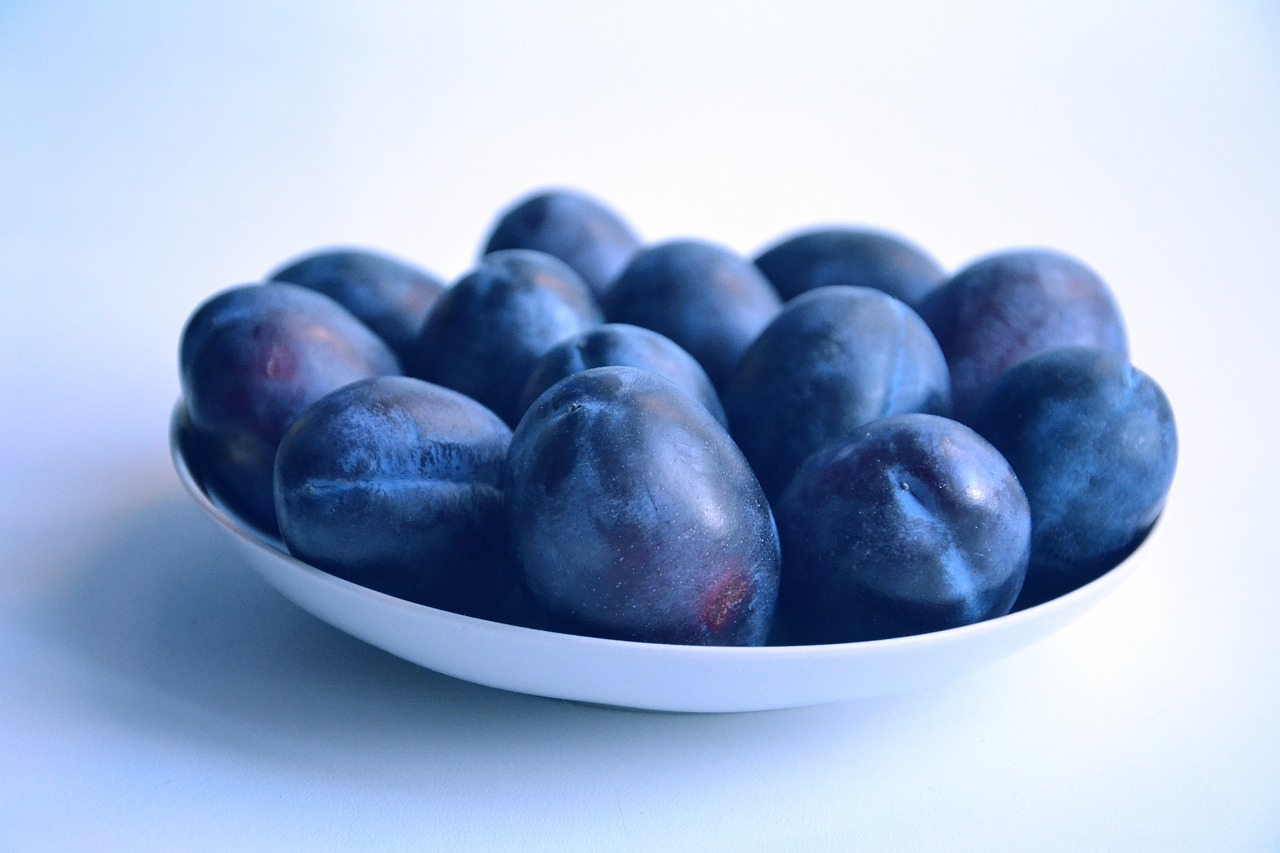
Understanding Your Pet's Nutritional Needs
When it comes to our furry friends, understanding their nutritional needs is like deciphering a secret code that unlocks the door to their health and happiness. Just like humans, pets require a balanced diet tailored to their unique circumstances. Factors such as age, breed, and health conditions play a significant role in determining what food will keep them thriving. For instance, a young puppy has different needs compared to a senior dog, just as a kitten's diet differs from that of an adult cat.
To start, it's essential to assess your pet's life stage. Puppies and kittens are in a phase of rapid growth and require food rich in proteins and essential nutrients. As they transition into adulthood, their dietary needs shift, and the focus should be on maintaining a healthy weight and supporting overall well-being. Senior pets, on the other hand, may benefit from diets formulated to support joint health and cognitive function. This evolution in dietary requirements is critical, and making the right choices can affect your pet's quality of life.
Next, consider your pet's breed. Some breeds are more prone to specific health issues, which can influence their dietary needs. For example, large breed dogs may require diets that promote healthy bone growth, while small breed dogs might need more calorie-dense foods due to their higher metabolism. Additionally, certain breeds may have sensitivities to particular ingredients, so being aware of these nuances is vital.
Health conditions also play a pivotal role in your pet's dietary requirements. Pets with allergies, diabetes, or kidney disease often need specialized diets. Consulting with your veterinarian can provide invaluable insights into what specific nutrients your pet may need or what to avoid. Regular check-ups can help monitor any changes in health and adjust their diet accordingly.
In summary, understanding your pet's nutritional needs is a dynamic process that requires attention and adaptability. By evaluating their age, breed, and health conditions, you can create a tailored diet plan that not only meets their nutritional requirements but also enhances their overall quality of life.
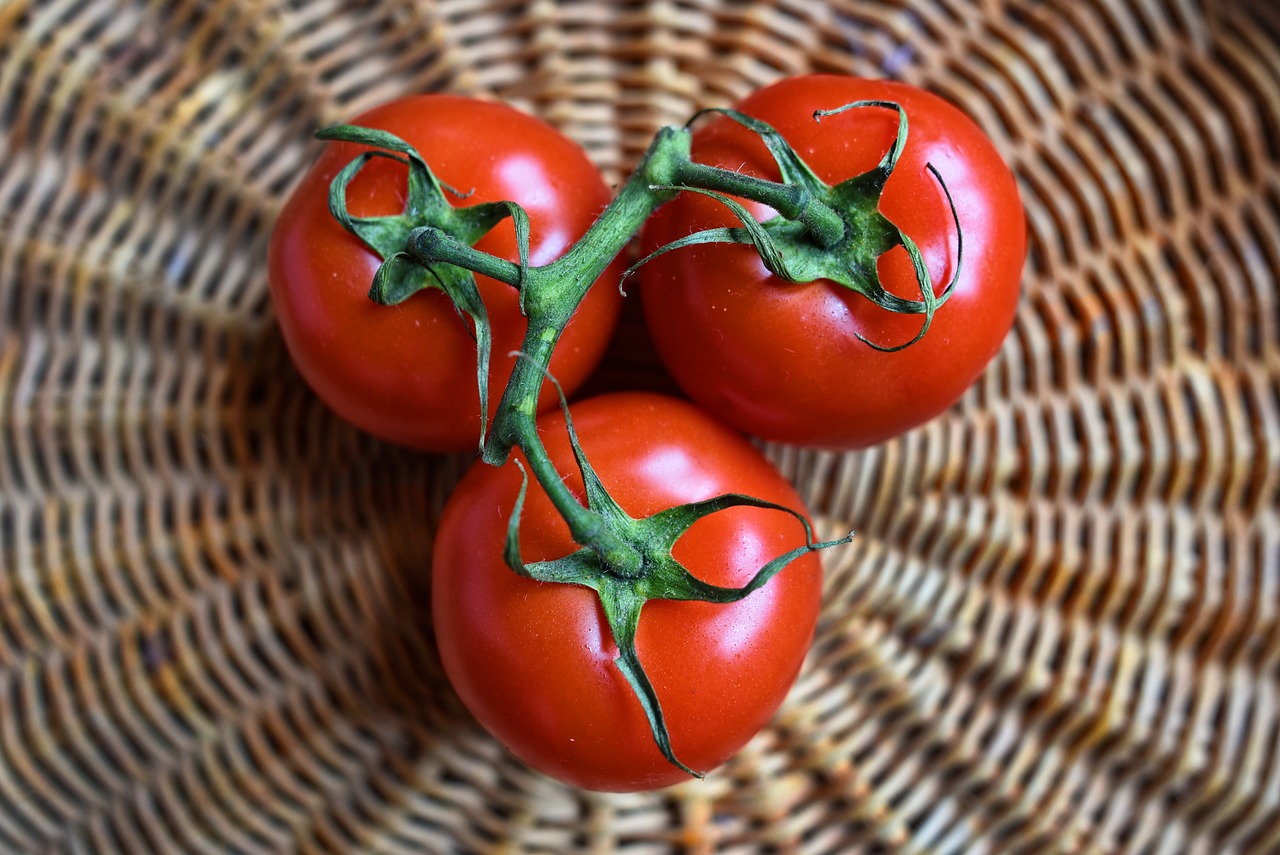
Choosing the Right Food
When it comes to your furry friend’s diet, the choices can feel as overwhelming as a kid in a candy store. With so many options on the shelves, it’s crucial to select the right food that caters to your pet's unique needs. Think of it like shopping for your own groceries: you wouldn’t just grab anything off the shelf without checking the labels, right? The same principle applies to your pet's food. You want to ensure that what you’re feeding them is not only delicious but also nutritious.
First, consider your pet’s specific requirements. Just like people, pets have different dietary needs based on their age, breed, and health conditions. For example, a growing puppy has different nutritional demands than a senior dog. Similarly, a cat with a sensitive stomach will require a different diet than a healthy adult cat. So, how do you navigate this maze of pet food options? Start by consulting your veterinarian. They can provide tailored advice based on your pet's health history and lifestyle.
Next, let’s talk about the quality of the food. You want to look for high-quality ingredients that will provide your pet with the necessary nutrients. A good rule of thumb is to choose foods that list a specific meat as the first ingredient. This indicates that the food is rich in protein, which is essential for your pet's energy and muscle development. Additionally, whole grains, vegetables, and healthy fats should be included in the ingredient list. Think of these components as the building blocks of your pet's diet.
Another important aspect is understanding how to read pet food labels effectively. It’s not just about picking the prettiest bag; you need to dive into the details. Look for the Guaranteed Analysis section, which provides information on the nutritional content. This includes the minimum percentages of protein and fat, as well as the maximum percentages of fiber and moisture. You want to ensure that the food meets the standards set for your pet's specific life stage.
Learning to read pet food labels is essential for making informed choices. Here are some key points to consider:
- Ingredients List: The ingredients are listed in descending order by weight. So, if a meat source is listed first, it’s a good sign!
- Specificity: Look for specific ingredients rather than vague terms. For instance, “chicken” is better than “meat by-products.”
- Preservatives: Avoid foods with artificial preservatives, colors, or flavors. Natural options are always better for your pet’s health.
While some ingredients are beneficial, others can be harmful. Here are a few common additives and fillers to steer clear of:
- By-products: These can include animal parts not deemed fit for human consumption.
- Fillers: Ingredients like corn and soy can be used to bulk up the food but offer little nutritional value.
- Artificial Additives: These can lead to health issues over time, so it’s best to avoid them.
On the flip side, knowing what constitutes quality ingredients is vital. Look for:
- Real Meat: As the first ingredient, it ensures high protein content.
- Whole Grains: Such as brown rice or oats, which provide energy and fiber.
- Fruits and Vegetables: These can offer vitamins and minerals that support overall health.
Choosing the right food for your pet is not just about filling their bowl; it’s about nurturing their health and happiness. By paying attention to ingredients, consulting with your vet, and understanding how to read labels, you can confidently select a diet that supports your pet's well-being. Remember, a happy pet is a healthy pet!
Reading Labels Effectively
When it comes to selecting the best food for your furry friend, reading pet food labels effectively is crucial. Just like when you shop for your own groceries, understanding what's in the bag can make a world of difference for your pet's health. But how do you decipher all that jargon? Don't worry; it's simpler than it sounds!
First off, you should always start with the ingredients list. This is where you’ll find the actual components of the food. Ingredients are listed in order of quantity, so the first few items are the most significant. Ideally, you want to see a high-quality protein source, like chicken or beef, at the top of the list. Avoid foods that list vague terms like "meat by-products" or "animal fat," as these can be red flags indicating lower quality.
Next, take a look at the guaranteed analysis. This section provides information on the minimum percentages of crude protein and fat, as well as the maximum percentages of fiber and moisture. It’s essential to compare these values to ensure the food meets your pet's specific dietary needs. For example, if you have an active dog, they might require a diet higher in protein and fat compared to a more sedentary dog.
Don't forget to check for nutritional adequacy statements. Look for phrases like "complete and balanced" or "meets AAFCO standards." These statements mean that the food has been formulated to provide all the essential nutrients your pet needs. If you see a vague claim, it might be best to move on to another brand.
It’s also wise to familiarize yourself with common ingredients that can be harmful. For instance, artificial preservatives like BHA, BHT, and ethoxyquin can be detrimental to your pet's health. Similarly, artificial colors and flavors might make the food more appealing to us, but they offer no nutritional benefit to your pet. Instead, look for natural preservatives like mixed tocopherols or ascorbic acid.
Finally, understanding the source of ingredients is essential. Many brands will proudly display where their ingredients come from, which can give you confidence in the quality of the food. For instance, ingredients sourced from reputable farms or fisheries are generally a good sign. If a label doesn't specify, it’s worth doing a little extra research or choosing a different product.
In summary, taking the time to read and understand pet food labels can significantly impact your pet's well-being. By focusing on high-quality ingredients, nutritional adequacy, and avoiding harmful additives, you're setting your furry friend up for a healthier life. So, the next time you find yourself in the pet food aisle, remember: knowledge is power!
Common Ingredients to Avoid
When it comes to your pet's diet, not all ingredients are created equal. In fact, some can be downright harmful! Just like we avoid certain foods for our health, our furry friends deserve the same careful consideration. It’s crucial to be vigilant about what goes into their bowls. Here’s a rundown of common ingredients you should steer clear of to keep your pet healthy and happy.
First up, artificial preservatives. These are often used to extend the shelf life of pet food, but they can lead to health issues in pets, including allergies and even cancer. Look out for ingredients like BHA, BHT, and ethoxyquin. These chemical additives might keep food fresh, but they can be detrimental to your pet's long-term health.
Next, we have fillers. These are often inexpensive ingredients like corn, wheat, and soy that don’t provide much nutritional value for your pet. They may fill your pet's stomach, but they won't nourish their body. Think of fillers as the junk food of the pet food world; they can lead to obesity and other health problems if used as a regular part of your pet's diet.
Another ingredient to avoid is by-products. While some by-products can be nutritious, many are low-quality scraps from meat processing. They can include anything from beaks and feathers to diseased organs. It’s best to choose foods that specify the meat source and avoid vague terms like "meat by-products" or "animal digest." Your pet deserves better than mystery meat!
Additionally, artificial colors and flavors are often added to make pet food more appealing to pet owners, but they provide no real benefit to your pet. These ingredients can cause allergic reactions and other health issues. Remember, your pet doesn’t care about the color of their food; they care about the taste and nutrition!
To give you a clearer picture, here’s a simple table summarizing these common ingredients to avoid:
| Ingredient | Why Avoid? |
|---|---|
| Artificial Preservatives (BHA, BHT) | Linked to health issues like allergies and cancer. |
| Fillers (Corn, Wheat, Soy) | Low nutritional value, can lead to obesity. |
| By-Products | Low-quality scraps, can include unhealthy parts. |
| Artificial Colors & Flavors | No nutritional benefit, can cause allergies. |
In summary, being aware of these common ingredients can make a significant difference in your pet's health. Always read labels carefully and opt for high-quality food that prioritizes your pet’s well-being. Remember, a little diligence goes a long way in ensuring your furry friend lives a long, healthy, and happy life!
Identifying Quality Ingredients
When it comes to choosing the right food for your furry friend, understanding what constitutes quality ingredients is essential. Just like we carefully select the foods we eat, our pets deserve the same level of attention. You wouldn’t want to feed your pet something that’s filled with fillers and artificial junk, right? Quality ingredients not only promote better health but also enhance your pet's overall well-being. So, how do you identify these premium ingredients?
First off, look for real meat as the primary ingredient. This is crucial because pets, especially dogs and cats, are carnivores by nature. Quality pet food will list a specific type of meat, such as chicken, beef, or fish, at the top of the ingredient list. This is a clear indicator that you’re providing your pet with the protein they need to thrive. For example, a label that states “chicken” is preferable to one that says “meat by-products.”
Next, consider the presence of whole grains or vegetables. Ingredients like brown rice, sweet potatoes, and peas are not only digestible but also provide essential nutrients and energy. However, be cautious of overly processed grains and fillers like corn and soy, which can lead to allergies and digestive issues. It’s a bit like choosing between a fresh salad and a bag of chips; one is packed with nutrients while the other is just empty calories.
Additionally, healthy fats are vital for your pet's diet. Look for sources like fish oil or chicken fat, which can promote a shiny coat and healthy skin. These ingredients are akin to the good fats we find in avocados and nuts—beneficial and necessary for overall health.
Another aspect to consider is the inclusion of fruits and vegetables. Ingredients like blueberries, carrots, and spinach are not just for decoration; they provide antioxidants, vitamins, and minerals that contribute to your pet's immune health. It’s like adding a burst of color and nutrients to your pet’s diet, enriching their meals and keeping them healthy.
To make it easier for you, here’s a quick table summarizing some quality ingredients versus those you should avoid:
| Quality Ingredients | Ingredients to Avoid |
|---|---|
| Real meat (e.g., chicken, beef, fish) | Meat by-products |
| Whole grains (e.g., brown rice, oats) | Processed grains (e.g., corn, wheat) |
| Healthy fats (e.g., fish oil, chicken fat) | Unknown animal fats |
| Fruits and vegetables (e.g., blueberries, carrots) | Artificial colors and preservatives |
In conclusion, identifying quality ingredients is a vital skill for any pet owner. By prioritizing real meat, wholesome grains, healthy fats, and nutrient-rich fruits and vegetables, you can ensure that your pet receives a balanced and nutritious diet. Remember, the better the ingredients, the happier and healthier your furry friend will be!
- What should I look for on a pet food label? Always check for real meat as the first ingredient, followed by wholesome grains and healthy fats.
- Are all grains bad for pets? Not at all! Whole grains like brown rice and oats can be beneficial, but avoid processed grains.
- How can I tell if my pet is allergic to a new food? Watch for symptoms like itching, digestive upset, or unusual behavior. If you see these signs, consult your vet.
- Is it necessary to consult a vet before changing my pet's diet? Yes, especially if your pet has existing health issues or dietary restrictions.
Transitioning to the New Diet
Transitioning your pet to a new diet can feel like trying to teach an old dog new tricks—daunting and sometimes messy! However, with the right approach, you can make this process smooth and stress-free for both you and your furry friend. The key is to introduce the new food gradually, allowing your pet's digestive system to adapt without causing any discomfort. Just like humans, pets can experience tummy troubles when faced with sudden changes in their diet.
Start by mixing a small amount of the new food with their current food. For instance, you might begin with a ratio of 25% new food to 75% old food. Over the course of about a week, you can gradually increase the proportion of new food while decreasing the old. This gradual shift helps your pet's digestive system adjust and reduces the likelihood of gastrointestinal issues, such as diarrhea or vomiting.
Here’s a simple step-by-step guide to help you through the transition:
- Day 1-3: Mix 25% new food with 75% old food.
- Day 4-6: Adjust the ratio to 50% new food and 50% old food.
- Day 7-9: Increase to 75% new food and 25% old food.
- Day 10: If all goes well, your pet should now be eating 100% new food!
During this transition, keep a close eye on your pet's behavior and health. Are they eating well? Are they experiencing any signs of discomfort? Monitoring their response is crucial, as it allows you to make necessary adjustments. If your pet shows signs of distress, such as lethargy or digestive upset, it may be wise to slow down the transition process. Sometimes, pets may require a longer adjustment period, especially if they are particularly sensitive to dietary changes.
Additionally, incorporating some of their favorite treats or wet food can make the new diet more appealing. Think of it as adding a little spice to a bland dish; it can make all the difference! However, be cautious not to overdo it, as too many treats can upset the balance you’re trying to achieve.
Lastly, remember that patience is key during this transition. Just like learning to ride a bike, it may take a little time for your pet to adjust to their new diet. With consistent monitoring and a gradual approach, you’ll find that your pet will adapt beautifully, leading to a healthier and happier life.
Q: How long should I take to transition my pet to a new diet?
A: Generally, a period of 7 to 10 days is recommended for most pets. However, some may require more time depending on their individual sensitivities.
Q: What if my pet refuses to eat the new food?
A: If your pet is hesitant, try mixing in their favorite treats or wet food to entice them. You can also ensure that the new food is served at room temperature, as pets often prefer it that way.
Q: Can I switch diets abruptly?
A: It's best to avoid abrupt changes as they can lead to digestive issues. Always aim for a gradual transition to ensure your pet's comfort.
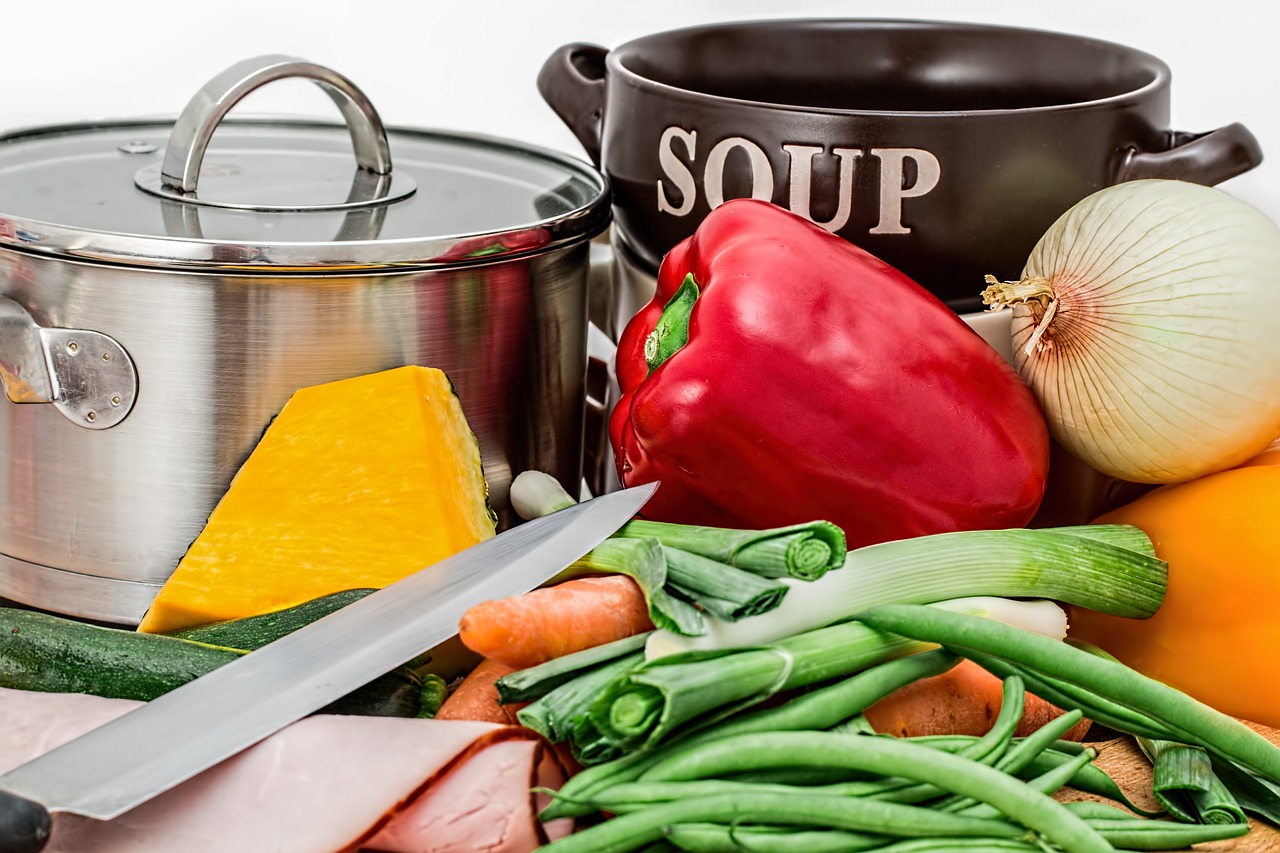
Monitoring Your Pet's Response
When it comes to introducing a new diet for your furry friend, monitoring their response is crucial. Just like humans, pets can have varying reactions to dietary changes, and being attentive can help you catch any potential issues early on. You might wonder, "What should I be looking for?" Well, let’s dive into the signs that indicate how well your pet is adapting to their new food.
First and foremost, keep an eye on their stool consistency. A sudden change in diet can lead to digestive upset, so you want to ensure their stools remain firm and regular. If you notice any signs of diarrhea or constipation, it could be a sign that the new food isn't sitting well with them. Similarly, pay attention to their energy levels. Is your pet more sluggish than usual, or are they bouncing off the walls? A lack of energy can indicate that the new diet isn't providing the necessary nutrients.
Another important aspect to monitor is your pet's appetite. Are they excited about meal times, or are they turning their nose up at the bowl? A sudden decrease in appetite could signal that they are not enjoying the new food or that it doesn't agree with them. On the flip side, if they seem overly eager to eat, it might be a good idea to check if you’re feeding the right portion sizes.
In addition to these physical signs, emotional changes can also be telling. If your pet seems more anxious or irritable than usual, it might be worth considering whether the new diet is contributing to their mood. Animals can be sensitive to changes in their routine, and food is a big part of that. Keeping a journal of your pet's behavior during the transition can help you spot patterns and make informed decisions. Here’s a simple table to help you track their response:
| Date | Food Type | Stool Consistency | Energy Level | Appetite | Notes |
|---|---|---|---|---|---|
| MM/DD/YYYY | New Food Name | Firm/Loose | High/Medium/Low | Good/Poor | Any additional observations |
Lastly, it's essential to be aware of allergic reactions. Some pets may develop sensitivities to new ingredients, so watch for signs such as itching, redness, or gastrointestinal distress. If you suspect your pet is having an allergic reaction, it’s best to consult your veterinarian immediately. Remember, your pet's health and happiness are the top priority, and being proactive can make all the difference.
Identifying Allergic Reactions
When you introduce a new diet to your beloved pet, it’s vital to keep a watchful eye for any signs of allergic reactions. Just like humans, pets can develop sensitivities or allergies to certain ingredients in their food. Imagine switching your favorite dish and suddenly feeling unwell; that’s how your pet might feel if they react negatively to their new meal. So, what should you be looking for?
Common symptoms of food allergies in pets can include:
- Itching and Scratching: If your pet seems to be scratching more than usual, especially around the ears, paws, or belly, it could be a sign of an allergic reaction.
- Digestive Issues: Vomiting or diarrhea shortly after eating can indicate that your pet's stomach is unhappy with the new food.
- Skin Irritations: Look for redness, rashes, or even hair loss, which can be a result of an allergic reaction.
- Ear Infections: Frequent ear infections can also signal food allergies, as the body reacts to irritants.
It’s essential to note that these symptoms can vary in intensity and may not all appear at once. If you observe any of these signs, it’s crucial to consult your veterinarian. They can help determine whether the symptoms are indeed related to the new diet or if there might be another underlying issue.
In some cases, your vet might recommend an elimination diet, where you feed your pet a limited ingredient diet to pinpoint the offending ingredient. This process can be a bit tedious, but it’s a necessary step to ensure your pet’s health and comfort. Think of it as detective work – you’re on a mission to find out what’s causing the discomfort!
Additionally, keeping a food diary can be beneficial during this transition phase. By documenting what your pet eats and any reactions they have, you can provide your vet with valuable information that can help in diagnosing food allergies. This record can be as simple as a notepad where you jot down meal times, ingredients, and any noticeable changes in behavior or health.
Ultimately, the goal is to ensure your pet thrives on their new diet without any adverse reactions. By being observant and proactive, you can help your furry friend enjoy their meals without the worry of allergies getting in the way.
Q: How long does it take for allergic reactions to appear after changing my pet's diet?
A: Allergic reactions can occur within hours or days after introducing a new food. It varies by individual pet and the specific ingredient involved.
Q: What should I do if I suspect my pet has a food allergy?
A: Consult your veterinarian immediately. They can help diagnose the issue and recommend an appropriate course of action.
Q: Can I try to identify the allergen myself?
A: While you can keep a food diary and monitor symptoms, it’s best to work with your vet for accurate diagnosis and treatment options.
Adjusting Feeding Portions
When it comes to transitioning your pet to a new diet, is a critical step that can significantly impact their health and well-being. Just like humans, pets can be sensitive to changes in their diet, and improper portion sizes can lead to issues such as obesity or malnutrition. So, how do you determine the right amount of food? It’s not just about following the guidelines on the packaging; it’s about understanding your pet's individual needs.
First, consider your pet's age, weight, and activity level. For instance, a young, active dog will require more calories than an older, less active one. The same goes for cats! If you're transitioning from one food to another, it’s essential to start with smaller portions and gradually increase them as your pet adjusts to the new diet. This approach not only minimizes digestive issues but also allows you to gauge how well your pet is responding to the food.
Here’s a simple formula to help you adjust portions effectively:
| Weight of Pet (lbs) | Daily Caloric Requirement (kcal) | Recommended Portion Size (cups) |
|---|---|---|
| 5 | 150 | 1/2 |
| 10 | 250 | 1 |
| 20 | 400 | 1.5 |
| 50 | 800 | 2.5 |
As you can see from the table above, the daily caloric requirement varies with the weight of your pet. It's important to note that these are just general guidelines and should be tailored to your pet's specific circumstances. For instance, if your pet is more active than average, you might want to increase their portion slightly. Conversely, if they tend to be a couch potato, reducing their portions could be beneficial.
Another crucial aspect to consider is the frequency of feeding. Depending on your pet's age and dietary needs, you might want to adjust how often you feed them. For example, puppies often require more frequent meals, while adult dogs and cats can thrive on two meals a day. This not only helps in managing their weight but also keeps their energy levels stable throughout the day.
Finally, always keep an eye on your pet's body condition. If they seem to be gaining weight, it might be time to cut back on portions. On the other hand, if they appear to be losing weight or seem lethargic, you may need to increase their food intake. Regular vet check-ups can also provide valuable insights into your pet's nutritional needs during this transitional phase.
In conclusion, adjusting feeding portions is an essential part of helping your pet adapt to a new diet. By understanding their individual needs, using a caloric guideline, and being mindful of their body condition, you can ensure a smooth and healthy transition. Remember, it’s all about finding the right balance!
- How long should I take to transition my pet to a new diet? It's generally recommended to take 7-10 days, gradually increasing the new food while decreasing the old one.
- What should I do if my pet refuses to eat the new food? Try mixing it with their favorite treats or wet food to entice them. Patience is key!
- Can I feed my pet homemade food? Yes, but ensure it meets their nutritional needs. Consulting with a vet is advisable.
Frequently Asked Questions
- How can I tell if my pet needs a diet change?
There are several signs that might indicate your pet needs a diet change. Look for changes in their energy levels, weight fluctuations, or digestive issues like diarrhea or vomiting. If your pet seems lethargic or is scratching more than usual, it might be time to reassess their diet. A visit to your vet can also help determine if their current food is meeting their nutritional needs.
- What should I consider when choosing a new pet food?
When selecting a new food for your pet, consider their age, breed, and any specific health issues. Look for high-quality ingredients and avoid foods with fillers like corn or soy. It’s also essential to check the nutritional content on the label to ensure it meets the dietary needs of your pet. Remember, just like us, pets thrive on balanced nutrition!
- How do I transition my pet to a new diet?
Transitioning your pet to a new diet should be a gradual process. Start by mixing a small amount of the new food with their current food. Over about a week, slowly increase the new food while decreasing the old food. This method helps avoid digestive upset and allows your pet to adjust to the new flavors and textures. Patience is key here!
- What are some common signs of food allergies in pets?
Common signs of food allergies in pets include itching, gastrointestinal issues like vomiting or diarrhea, and skin irritations. If you notice any unusual behavior or symptoms after changing their diet, it’s important to consult your veterinarian. They can help determine if an allergy is present and guide you on how to proceed.
- How can I monitor my pet's response to a new diet?
Keep an eye on your pet's behavior, energy levels, and overall health during the transition. Regularly check their stool for consistency and watch for any signs of discomfort. If you notice any adverse reactions, consult your veterinarian immediately. It’s crucial to ensure that the new diet is a good fit for your furry friend!
- What should I do if my pet refuses to eat the new food?
If your pet is hesitant to eat the new food, try mixing it with their favorite treats or a bit of wet food to make it more appealing. Sometimes, a little creativity can go a long way! If they continue to refuse, it may be worth revisiting the type of food you're offering or consulting your vet for alternatives.
- Is it necessary to consult a vet before changing my pet's diet?
Yes, consulting a veterinarian before making any significant changes to your pet's diet is highly recommended. They can provide tailored advice based on your pet's specific needs, health status, and any dietary restrictions they may have. A vet's guidance can ensure a safe and healthy transition to a new diet.

